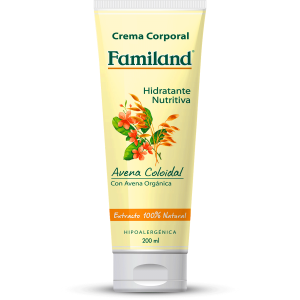Familand Crema Corporal Avena Coloidal

Ingredientes
COLLOIDAL OATMEAL
AQUA
PROPYLENE GLYCOL
HONEY EXTRACT
OPUNTIA TUNA EXTRACT
PYRUS COMMUNIS EXTRACT
PASSIFLORA QUADRANGULARIS FRUIT EXTRACT
MINERAL OIL
GLYCERYL STEARATE
PEG-100 STEARATE
POLYACRYLAMIDE
C13-C14 ISOPARAFFIN
LAURETH-7
CETEARYL ALCOHOL
PHENOXYETHANOL
CAPRYLYL GLYCOL
PARFUM
B.H.T
TRIETHANOLAMINE
Más información
Avena Orgánica 100% Natural. Sin Parabenos. Sin Colorantes. Hipoalergénico Dermatológicamente Testeado. Cruelty Free. PASSIFLORA QUADRANGULARIS FRUIT EXTRACT (COMPLEJO HIDRATANTE VEGETAL)
El análisis de ingredientes ha sido elaborado por investigadores del CONICET (*) en base a las siguientes referencias bibliográficas:
- Final Report on the Safety Assessment of Propylene Glycol and Polypropylene Glycols. (1994). Journal of the American College of Toxicology, 13(6), 437–491.
- US - FOOD & DRUG Administration (FDA). Generally Recognized as Safe (GRAS) Substances (SCOGS) Database (SCOGS Number 27,1973. Conclusion 1)
- AOEC (Association of Occupational and Environmental Clinics). 2009. AEOC exposures codes and asthmagen designation.
- K. Aschenbeck, E. Warshaw. Allergenic Ingredients in Facial Wet Wipes. Dermatitis (2017) 28(6):353–359
- A. C. de Groot, H. L. M. van der Meeren, J. Willem Weyland. Contact Dermatitis (1988) 19: 77-78
- Cosmetic Ingredient Review (CIR)
- Final Report of the Amended Safety Assessment (2004). International Journal of Toxicology, 23 (2), 55–94.
- List of Safe and/or Natural Ingredients
- Berndt, W. O., W. F. Bergfeld, R. K. Boutwell, W. W. Carlton, D. K. Hoffmann, A. L. Schroeter, and R. C. Shank. Final report on the safety assessment of polyacrylamide. Journal of the American College of Toxicology 10, no. 1 (1991): 193-203.
- Cosmetic Ingredient Review (CIR), Safety Assessment of Polyene Group as Used in Cosmetics Report (2008)
- Material Safety Data Sheet MSDS# 96171
- Chasset, F., Soria, A., Moguelet, P., Mathian, A., Auger, Y., François, C., and Barete, S. (2015). Contact dermatitis due to ultrasound gel: A case report and published work review. The Journal of dermatology.
- Bohn, S., and Bircher, A. J. (2001). Phenoxyethanol induced urticaria. Allergy, 56(9), 922-923.
- European Chemical Agency (ECHA)
- SCCNFP (The Scientific Committee on Cosmetic Products and Non-Food Products Intended for Consumers) 1999. Opinion concerning fragrance allergy in consumers. A review of the problem. Analysis of the need for appropriate consumer information and identification of consumer allergens. SCCNFP/0017/98 Final. December 199 - Tatyana Hamilton and Gillian C de Gannes. 2011. Allergic contact dermatitis to preservatives and fragrances in cosmetics. Skin therapy letter 16(4), 1-4 .- Anne Birgitte Simonsen, Mette Deleuran, Jeanne Duus Johansen and Mette Sommerlund 2011. Contact allergy and allergic contact dermatitis in children - a review of current data. Contact dermatitis 65(5), 254-65.
- L. Gue, What's Inside? That Counts. A Survey of Toxic Ingredients in our Cosmetics (2010), Pg. 10 and 11.
- European Food Safety Authority 2012. EFSA. 2012. Panel on Food Additives and Nutrient Sources added to Food (ANS)
- Scientific Opinion on the re-evaluation of Butylated hydroxytoluene BHT (E 321) as a food additive. EFSA Journal 10(3), 2588.
- Material Safety Data Sheet MSDS# 23930
- https://www.cosmeticsinfo.org/ingredient/triethanolamine.
- Stout, M. D., Kissling, G. E., Suárez, F. A., Malarkey, D. E., Herbert, R. A., & Bucher, J. R. (2008). Toxicologic pathology, 36(6), 783-794.
- ACGIH, IARC, NTP, or CA Prop 65.
(*) Según el ranking SCImago 2020, el CONICET alcanza la segunda posición entre las instituciones académicas y de investigación más prestigiosas de América Latina. A nivel mundial, ocupa la posición 230 entre 7000 instituciones privadas y gubernamentales.

